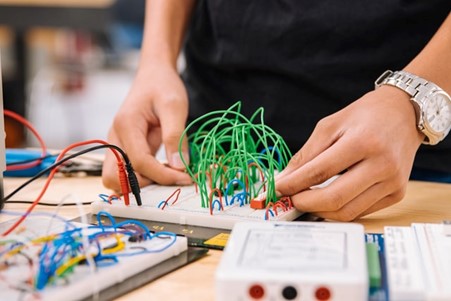Dr. Gerard Jellig serves as Instructional Superintendent in DC public schools and an adjunct professor of organizational theory at the University of Pennsylvania. In the following article, Jerry Jellig discusses new developments in STEM education.
The STEM fields—science, technology, engineering, and mathematics—remain some of the most challenging subjects to teach, in large part due to the everchanging, ever-advancing research they produce. Yet, Jerry Jellig says leading educators around the nation continue to grow and learn new ways to better teach their students.
Here, Dr. Gerard Jellig explores a handful of the ways that STEM educators are improving their pedagogy to better serve today’s youth. By incorporating the latest technologies into existing learning models, shifting towards applied understandings, and producing more engaging learning tools, STEM educators have consistently improved their lessons.
Virtual and Augmented Reality Improves Engagement
For generations, STEM educators have struggled to convey complex ideas such as cellular structure, atomic bonds, and the sheer scale of the universe. Dr. Gerard Jellig says without effective ways to visualize these concepts, students often get bored and lose attention during what could potentially become an exciting lesson. However, recent advancements in AR and VR technologies have allowed teachers to keep their students engaged.
For example, the Google Expeditions app uses AR to take students on virtual reality field trips, providing them with an immersive experience that is otherwise difficult to recreate in a classroom setting. Jerry Jellig says these same technologies can also be used to create interactive 3D models of molecules or cells, providing students with a more hands-on way to learn about the building blocks of life.
Dr. Gerard Jellig explains that the use of AR and VR in STEM education is still in its early stages, but it is clear that these technologies have the potential to revolutionize the way students learn. As more and more schools begin to adopt these technologies, we can expect to see a shift in the way STEM is taught.
These technologies have the potential to make learning more engaging and exciting for students and, with the help of AR and VR, teachers will be able to provide their students with a more immersive and interactive learning experience.
Jerry Jellig on Applied Learning in STEM
In addition to using the latest technologies, Jerry Jellig explains that many STEM educators are also shifting their focus toward applied learning. By emphasizing the real-world applications of the concepts they are teaching, educators can better engage their students and help them see the importance of what they are learning. One way to achieve this is by incorporating problem and concept-based learning into math lessons.
Dr. Gerard Jellig says in problem-based learning, students are presented with real-world problems and use concepts they have already learned to solve them. This type of learning has been shown to improve student motivation, engagement, and understanding of the material. Through basic scaffolding, students build on the material they’ve already learned and reach a conceptual rather than procedural understanding of math that they can apply outside the confines of a standard classroom.
Another way to achieve this is by having students work on projects that they can actually use in the real world. For example, Jerry Jellig says students in engineering classes might design a new type of prosthetic limb, or students in physics classes might build working models of a solar system. By working on projects that have real-world applications, students can better see the value of what they are learning.
STEM-Based Learning Through Toys
Even at the elementary school level, educators have been better able to introduce complex topics thanks to a recent increase in the number of STEM-related toys. Dr. Gerard Jellig says these toys, which are designed to teach children basic concepts in a fun and engaging way, have become increasingly popular in recent years.
Jerry Jellig explains that one example is the GoldieBlox line of toys, which are designed to teach girls basic engineering concepts through the use of construction kits. These kits allow girls to build working machines such as zip lines and Ferris wheels, providing them with a hands-on way to learn about the principles of engineering.
Another example is the popular toy robot, Dash. The Dash robot is a small, round robot that can be programmed to perform various tasks and is controlled by a mobile app, which is used to input commands. The commands are then executed by the robot, which can move, make sounds, and even display facial expressions.
Dr. Gerard Jellig says the increased availability of STEM-based toys is having a positive impact on the way children are learning about these concepts. The use of these toys allows children to learn in a more hands-on and engaging way, helping to increase interest in STEM subjects and leading to a better understanding of the concepts being taught.
Final Thoughts
These are just a few of the ways that STEM educators are improving their pedagogy. Dr. Gerard Jellig says by utilizing the latest technologies, shifting towards applied learning, and producing more engaging learning tools, they have been able to better engage their students and help them understand the importance of STEM concepts.








